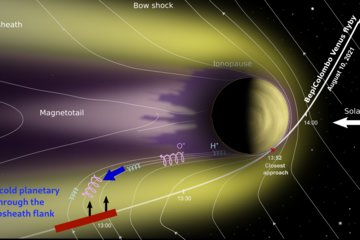All genres
61.
Journal Article
Sixteen Years of Ulysses Interstellar Dust Measurements in the Solar System. II. Fluctuations in the Dust Flow from the Data. Astrophysical Journal 812, pp. 140 - 154 (2015)
62.
Journal Article
The science case for an orbital mission to Uranus: Exploring the origins and evolution of ice giant planets. Planetary and Space Science 104, pp. 122 - 140 (2014)
63.
Journal Article
Dust Impact Monitor (DIM) onboard Rosetta/Philae: Tests with ice particles as comet analog materials. Planetary and Space Science 99, pp. 128 - 135 (2014)
64.
Journal Article
Collecting cometary dust particles on metal blacks with the COSIMA instrument onboard ROSETTA. Planetary and Space Science 103, pp. 309 - 317 (2014)
65.
Journal Article
Kometen - Kleinkörper aus Eis und Staub; Neue Erkenntnisse der Kometenforschung. Interstellarum Themenheft Kometen (1/2014), pp. 16 - 23 (2014)
66.
Journal Article
Rosetta/Philae: Landung auf einem Kometen. Sterne und Weltraum (11), pp. 28 - 29 (2014)
67.
Journal Article
Rosetta - Rendezvous mit einem Kometen. Sterne und Weltraum 04/2014, pp. 32 - 42 (2014)
68.
Journal Article
KNN classification evaluated by repeated double cross validation: Recognition of minerals relevant for comet dust. Chemometrics and Intelligent Laboratory Systems 138, pp. 64 - 71 (2014)
69.
Journal Article
Dust Impact Monitor (DIM) onboard Rosetta/Philae: Comparison of experimental results and the theory behind the experiment. Planetary and Space Science 84, pp. 122 - 130 (2013)
70.
Journal Article
Die Beute des Wanderfalken - Staub vom Asteroiden Itokawa ist nun alnalysiert. Sterne und Weltraum 01-2013, pp. 44 - 48 (2013)
71.
Journal Article
Aktive Asteroiden - Eine neue Gruppe von Kleinkörpern im Sonnensystem. Sterne und Weltraum 10/2013, pp. 32 - 37 (2013)
72.
Journal Article
Dust environment prediction for the ESA L-Class mission candidate JUICE. Planetary and Space Science 75, pp. 117 - 128 (2013)
73.
Journal Article
The filtering of interstellar dust in the solar system. Astronomy and Astrophysics 552, A130 (2013)
74.
Journal Article
Komet Tempel 1 unter der Lupe. Sterne und Weltraum 07/2012, pp. 42 - 45 (2012)
75.
Journal Article
50 Jahre Planetenforschung - Vorstoß ins Sonnensystem: Teil 1: Die erdähnlichen Planeten. Sterne und Weltraum 08/2012, pp. 32 - 41 (2012)
76.
Journal Article
50 Jahre Planetenforschung - Aus fernen Welten; Teil 2: Die Gasriesen, ihre Monde und die Kleinkörper. Sterne und Weltraum 09/2012, pp. 46 - 56 (2012)
77.
Journal Article
SARIM PLUS - Sample Return of Comet 67P/CG and of Interstellar Matter. Experimental Astronomy 33, pp. 723 - 751 (2012)
78.
Journal Article
An optimum opportunity for interstellar dust measurements by the JUICE mission. Planetary and Space Science 71, pp. 142 - 146 (2012)
79.
Journal Article
Magnetic field modulated dust streams from Jupiter in interplanetary space. Planetary and Space Science 59, pp. 1455 - 1471 (2011)
80.
Journal Article
Stardust-Next - der zweite Besuch beim Kometen Tempel 1. Sterne und Weltraum 02, pp. 32 - 38 (2011)











